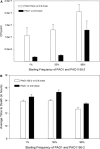Spite versus cheats: competition among social strategies shapes virulence in Pseudomonas aeruginosa
- PMID: 23106711
- PMCID: PMC3795443
- DOI: 10.1111/j.1558-5646.2012.01706.x
Spite versus cheats: competition among social strategies shapes virulence in Pseudomonas aeruginosa
Abstract
Social interactions have been shown to play an important role in bacterial evolution and virulence. The majority of empirical studies conducted have only considered social traits in isolation, yet numerous social traits, such as the production of spiteful bacteriocins (anticompetitor toxins) and iron-scavenging siderophores (a public good) by the opportunistic pathogen Pseudomonas aeruginosa, are frequently expressed simultaneously. Crucially, both bacteriocin production and siderophore cheating can be favored under the same competitive conditions, and we develop theory and carry out experiments to determine how the success of a bacteriocin-producing genotype is influenced by social cheating of susceptible competitors and the resultant impact on disease severity (virulence). Consistent with our theoretical predictions, we find that the spiteful genotype is favored at higher local frequencies when competing against public good cheats. Furthermore, the relationship between spite frequency and virulence is significantly altered when the spiteful genotype is competed against cheats compared with cooperators. These results confirm the ecological and evolutionary importance of considering multiple social traits simultaneously. Moreover, our results are consistent with recent theory regarding the invasion conditions for strong reciprocity (helping cooperators and harming noncooperators).
© 2012 The Author(s). Evolution© 2012 The Society for the Study of Evolution.
Figures






References
-
- Bashey F, Young SK, Hawlena H, Lively CM. Spiteful interactions between sympatric natural isolates of Xenorhabdus bovienii benefit kin and reduce virulence. J. Evol. Biol. 2012;25:431–437. - PubMed
-
- Bodilis J, Ghysels B, Osayande J, Matthijs S, Pirnay JP, Denayer S, De Vos D, Cornelis P. Distribution and evolution of ferripyoverdine receptors in Pseudomonas aeruginosa. Env. Microbiol. 2009;11:2123–2135. - PubMed
-
- Bowles S, Gintis H. The evolution of strong reciprocity: cooperation in heterogeneous populations. Theor. Popul. Biol. 2004;65:17–28. - PubMed
-
- Bremermann HJ, Pickering J. A game-theoretical model of parasite virulence. J. Theor. Biol. 1983;100:411–426. - PubMed
-
- Brown SP, Buckling A. A social life for discerning microbes. Cell. 2008;135:600–603. - PubMed
Publication types
MeSH terms
Substances
Grants and funding
LinkOut - more resources
Full Text Sources
Other Literature Sources
Molecular Biology Databases
